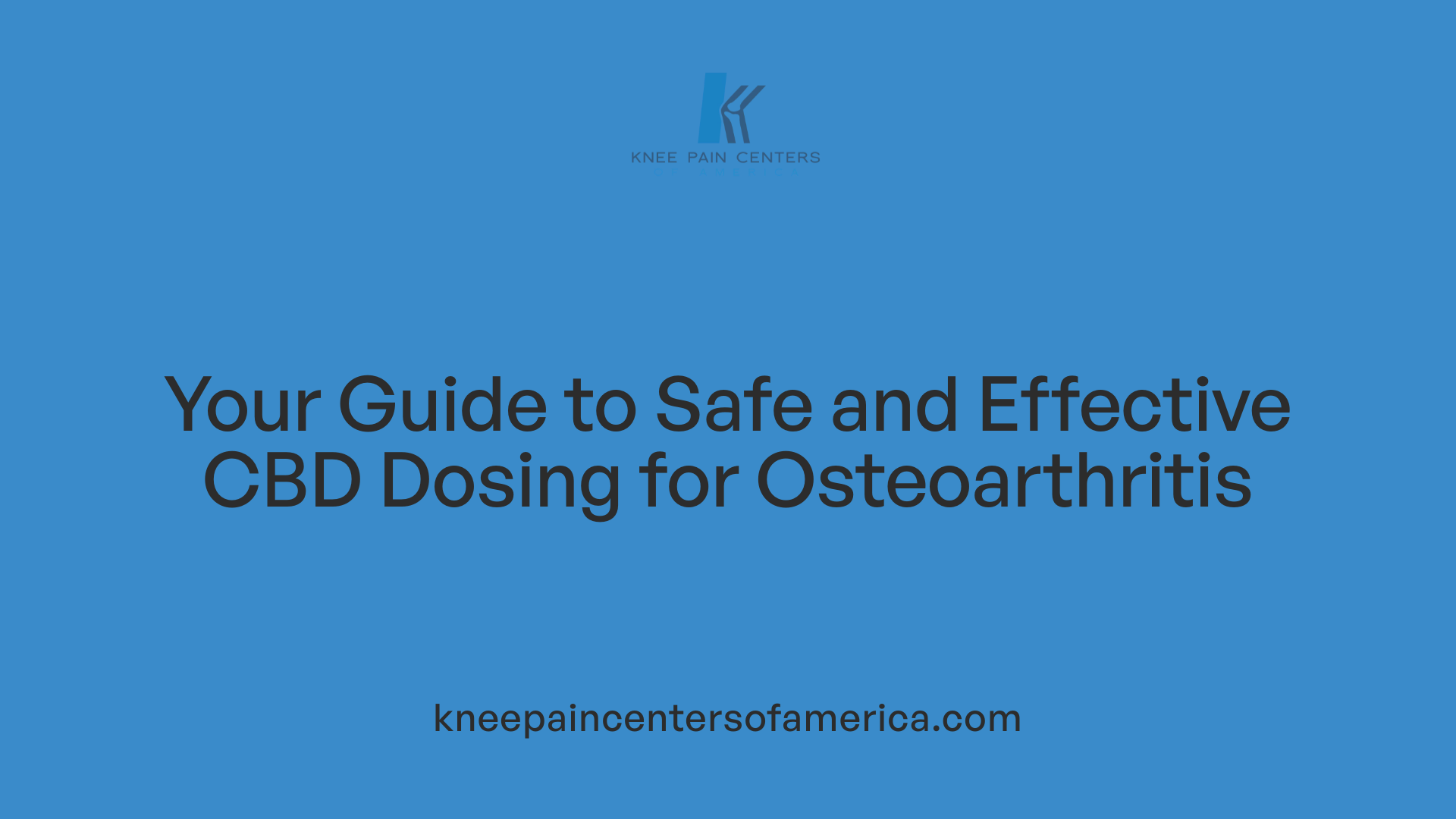Introduction to CBD and Osteoarthritis
Osteoarthritis (OA) is a common degenerative joint condition that causes pain, stiffness, and reduced function. With traditional treatments like medications and physical therapy sometimes insufficient or accompanied by side effects, many patients are exploring alternative options such as cannabidiol (CBD). While preliminary research indicates promising benefits, understanding the scientific basis, effectiveness, safety, and legal status of CBD is essential for informed decision-making.
Scientific Evidence and Research on CBD for Osteoarthritis
How effective is CBD for osteoarthritis?
The current understanding of CBD’s effectiveness in treating osteoarthritis (OA) relies heavily on early-stage research and patient reports rather than definitive clinical evidence. Animal studies have demonstrated that cannabinoids, including CBD, can reduce joint pain, inflammation, and nerve damage associated with OA. For instance, various animal models, such as the monosodium iodoacetate model, show that activation of the endocannabinoid system (ECS) in joints can help manage symptoms.
In humans, small studies and surveys suggest some positive outcomes. A 2020 survey of self-selected individuals with arthritis reported that 83% experienced a decrease in pain, while 66% noted improvements in sleep and physical function. Participants with osteoarthritis specifically reported a 44% reduction in pain after using CBD, a result that was statistically significant. Furthermore, the osteoarthritis group in these studies showed a greater percentage reduction in pain compared to those with rheumatoid or other autoimmune types of arthritis.
Patients also reported that CBD helped them reduce reliance on traditional medications like anti-inflammatories and opioids; over 60% of users noted support in decreasing or stopping such drugs, particularly with increased CBD use over time. These subjective reports extend to improvements in morning stiffness, sleep quality, and mood, along with reductions in fatigue and anxiety.
However, while these findings are promising, they are based on small-scale studies, surveys, and anecdotal evidence. High-quality, large-scale clinical trials are lacking, and current research does not provide definitive proof of CBD’s efficacy or safety for OA. Differences in product quality, dosages, and individual responses make it hard to draw firm conclusions.
The regulation of CBD products is limited, and many products on the market vary significantly in CBD concentration and purity, sometimes containing unlisted THC levels. Without standardized dosing guidelines or robust clinical trials, healthcare providers and consumers must approach CBD use cautiously.
In summary, preliminary research and patient-reported outcomes suggest CBD may offer relief from osteoarthritis symptoms through pain reduction, improved sleep, and decreased inflammation. Still, further rigorous studies are essential to establish its true effectiveness and safety profile.
Available CBD Products for Osteoarthritis Pain Relief
What types of CBD products are available for osteoarthritis pain relief, and which are most effective?
CBD products for osteoarthritis are offered in multiple forms, catering to different preferences and treatment goals. The main types include topicals, oils, capsules, gummies, and tinctures.
Topicals are often preferred by those with joint pain because they can be applied directly to affected areas, providing localized relief. Creams, balms, and patches containing CBD are designed to target inflammation and pain at specific sites, reducing systemic exposure.
Oils and tinctures, usually administered under the tongue, are taken for broader systemic effects. They are absorbed quickly and can be adjusted in dosage easily, allowing for personalized treatment. Edibles like gummies or capsules provide a convenient, discreet way to consume CBD, though they take longer to affect compared to sublingual oils.
Recent research indicates that full-spectrum CBD oils, which contain a range of cannabinoids and terpenes, may offer more pronounced benefits due to the entourage effect—where multiple compounds work synergistically to enhance therapeutic outcomes.
While subjective reports and preliminary studies suggest that these products may reduce pain and inflammation, the scientific evidence remains limited. Most studies in this field are animal-based or involve small human samples, so definitive claims about effectiveness are premature.
When choosing a CBD product for osteoarthritis, it’s vital to select high-quality options tested by independent laboratories. Consumers should look for products made in the U.S. with clear labeling of CBD content and absence of harmful contaminants.
Dosing guidelines generally recommend starting with a low dose—about 5 to 10 milligrams—taken twice daily, then gradually increasing based on response and tolerability. Consulting a healthcare provider can help optimize the treatment plan and ensure safety, especially if other medications are involved.
In summary, while various forms of CBD are available, topical applications and oils tend to be favored for joint-specific pain relief. Ongoing research and regulatory improvements are expected to clarify their roles and efficacy in managing osteoarthritis symptoms.
Guidelines for Selecting and Using CBD for Osteoarthritis
How can I select and use CBD products for osteoarthritis pain management?
Choosing the right CBD products for osteoarthritis involves careful consideration of product quality, formulation, dosage, and medical guidance. Since the market is largely unregulated, it's crucial to focus on reputable brands that meet strict standards.
Start by opting for products made in the U.S., ideally those tested by independent laboratories. These tests verify the potency and safety of the product, confirming the absence of contaminants such as heavy metals, pesticides, or THC beyond legal limits.
When beginning your CBD regimen, a low dose of 5 to 10 milligrams twice daily is often recommended. This allows your body to adjust while minimizing potential side effects. You can increase the dose gradually if needed, always paying close attention to your body's response.
CBD is available in several forms, each suited for different needs:
| Form | Pros | Cons | Suitable For |
|---|---|---|---|
| Capsules & Tinctures | Systemic effects, easy to dose | Slower onset | Overall pain management |
| Topicals | Targeted relief, no systemic exposure | Limited to local areas | Joint pain on specific sites |
| Edibles & Sprays | Discreet, portable | Variable absorption | Flexible dosing |
| Inhalation (vapor) | Fast onset | Potential respiratory irritation | Sudden flare-ups |
For localized joint pain, topical creams or balms applied directly to affected areas can be effective. Oral forms like capsules or tinctures are used for broader symptom management.
Monitoring your response and any side effects is essential. Keep a symptom and dose diary to track changes in pain levels, sleep quality, and any adverse effects such as dry mouth or drowsiness.
Before starting CBD, consulting your healthcare provider is vital, especially if you're taking other medications or have underlying health conditions. CBD can interact with certain drugs, including blood thinners and anti-inflammatory medications.
CBD should be used as a complementary therapy alongside other osteoarthritis management strategies, like physical therapy, weight control, and prescribed medications. Avoid unsubstantiated claims and be cautious with products claiming miracle cures.
In summary, selecting high-quality, lab-tested CBD products, starting with low doses, and working closely with your healthcare provider can help you safely explore whether CBD may alleviate your osteoarthritis symptoms. Regular monitoring ensures safe use and helps maximize potential benefits while minimizing risks.
Legal and Regulatory Aspects of CBD in Osteoarthritis Management

What is the regulatory status of CBD related to osteoarthritis treatment?
The legal and regulatory environment surrounding CBD, especially in the context of osteoarthritis, is complex and varies across regions. In the United States, the 2018 Hemp Farming Act paved the way for hemp-derived CBD products containing less than 0.3% THC to be legally sold at the federal level. This means that, federally, many CBD products are considered legal as long as they meet these criteria.
However, despite this federal leniency, the Food and Drug Administration (FDA) has not officially approved CBD for the treatment of osteoarthritis or any other medical condition. This lack of approval means that CBD remains an off-label substance that is largely unregulated in terms of quality, dosage, and safety. The FDA has repeatedly called for a clearer regulatory pathway to better oversee the manufacturing and marketing of CBD products.
State laws add another layer of complexity. Regulations can be stricter or more lenient depending on local jurisdiction. Some states have implemented their own rules requiring licenses, testing, and quality control, while others have broader allowances. For example, some states permit the sale of CBD in various forms, including edibles and topicals, whereas others impose restrictions or bans.
Access to CBD for osteoarthritis often depends on obtaining a medical marijuana card or prescription, especially if the product contains higher levels of THC. In many cases, patients need to consult healthcare providers and follow legal protocols to purchase and use CBD products lawfully.
Due to the current regulatory landscape, consumers should exercise caution. It is advisable to look for products made in the U.S., tested by independent laboratories, and transparency about their ingredients. These measures help ensure product safety and quality, although due to the unregulated market, inconsistencies still exist.
In summary, while CBD derived from hemp is generally legal federally in the U.S., its use for osteoarthritis remains off-label without robust clinical validation. Legal access and regulation are subject to ongoing changes and vary significantly by state, emphasizing the importance of staying informed and consulting healthcare professionals for safe use.
Mechanisms of Action: How CBD Alleviates Osteoarthritis Symptoms
How does CBD work to alleviate osteoarthritis symptoms?
CBD, or cannabidiol, interacts with the body's endocannabinoid system (ECS), which is crucial in controlling pain, inflammation, mood, and other bodily functions. The ECS comprises receptors, primarily CB1 and CB2, which are involved in different processes. CB1 receptors are widely present in the brain and nervous system pathways responsible for pain perception. CB2 receptors are more common in immune cells and are integral to the regulation of inflammation.
Animal studies have demonstrated that cannabinoids like CBD can reduce inflammation and nerve damage associated with osteoarthritis. It does so by inhibiting inflammatory cytokines — proteins that promote inflammation and joint swelling. Additionally, CBD modulates pain receptors in the brain, decreasing the sensation of pain, which can be particularly beneficial for those with joint discomfort.
CBD’s antioxidant properties further support joint health by neutralizing free radicals, which are molecules that can cause tissue damage. This may help in protecting the joints from further deterioration. Evidence from early trials and patient reports suggest that CBD can help reduce pain, improve sleep, and lower anxiety in individuals with osteoarthritis.
However, despite these promising mechanisms, the scientific community recognizes that conclusive evidence from large clinical trials is still lacking. Most available data stems from animal models or small human surveys that suggest potential benefits. While many users observe symptom relief, more rigorous research is essential to confirm CBD’s effectiveness and establish optimal dosages.
Overall, CBD’s interaction with the ECS appears to reduce inflammation and modulate pain pathways, making it a promising option for managing osteoarthritis symptoms as part of a comprehensive treatment plan. Nevertheless, patients should consult healthcare providers and consider the current limitations in scientific evidence before relying solely on CBD for symptom relief.
CBD’s Impact on Inflammation and Pain in Osteoarthritis

What does current research indicate about the effectiveness of CBD in reducing inflammation and pain in osteoarthritis?
Research into CBD's effects on osteoarthritis (OA) suggests it may have promising anti-inflammatory and pain-relief properties. Animal studies have consistently shown that cannabinoids like CBD can reduce joint inflammation and nerve damage associated with OA. Specifically, in models where joints are artificially inflamed, CBD has demonstrated the ability to diminish swelling and inhibit inflammatory processes.
Some small-scale human studies support these findings. For instance, a feasibility trial involving osteoarthritis patients reported that topical CBD application led to significant reductions in pain and improvements in hand function. Participants also experienced better sleep quality and less morning stiffness, highlighting the potential holistic benefits of CBD in managing OA symptoms.
However, it is important to note that most current research is limited. Many studies are small, with limited participants, and often lack the rigorous controls needed for definitive conclusions. Large-scale, high-quality clinical trials are still needed to confirm these early findings. Without substantial evidence from such studies, CBD cannot yet be recommended as a standard treatment for reducing joint inflammation and pain.
Nonetheless, preliminary data suggest that CBD might be a useful part of a wider osteoarthritis management plan, especially for those who do not respond well to traditional medications. Patients and healthcare providers should approach CBD use cautiously—starting with low doses, choosing products tested by independent labs for quality, and monitoring for side effects or potential drug interactions.
In summary, while current research indicates promising anti-inflammatory and analgesic effects of CBD in osteoarthritis, further rigorous studies are essential to establish safety, optimal dosing, and efficacy. As the science evolves, CBD remains a potential adjunct therapy that warrants careful consideration and clinical validation.
Additional Effects of CBD on Mental and Sleep Health

What are common questions about dosing and usage of CBD for osteoarthritis pain relief?
Many individuals interested in using CBD for osteoarthritis pain wonder about the appropriate dosage and how to use it effectively. The typical starting dose for adults is generally recommended to be around 5 to 10 milligrams of CBD presented in liquid form. This dose is usually taken twice daily, ideally sublingually (under the tongue), allowing for better absorption.
Patients are advised to increase the dose gradually if needed, based on how they respond and tolerability. Since research findings remain inconclusive and CBD products are often unregulated, the concentration of CBD can vary significantly between brands and batches. Therefore, starting with a low dose and monitoring effects through a symptom and dose diary is a prudent approach.
There are various forms of CBD administration, including capsules, edibles, sprays, tinctures, topical creams, and inhaled forms like vaping or smoking. Each method has its advantages and disadvantages. For instance, tinctures absorbed under the tongue act faster, while capsules offer convenience and longer-lasting effects.
Importantly, consulting a healthcare provider before initiating CBD use is crucial, especially if the individual is taking other medications. CBD can interact with certain drugs, including those metabolized by the liver or affecting fertility. A healthcare professional can help determine a safe and effective dosage, monitor for side effects, and ensure that CBD complements existing treatments.
Overall, starting with a small dose, increasing gradually, and choosing the most suitable administration method can help optimize the potential benefits of CBD while minimizing risks.
Risks, Side Effects, and Precautions for CBD Use in Osteoarthritis
What are the potential risks and safety considerations of using CBD for osteoarthritis?
Using CBD for osteoarthritis can have some safety considerations that users should be aware of. While many people tolerate CBD well, it may cause mild side effects such as dry mouth, drowsiness, appetite changes, diarrhea, and fatigue. These effects are generally temporary and not severe, but they can be bothersome for some individuals.
An important aspect to consider is interaction with other medications. CBD has the potential to affect how certain drugs work in the body, particularly blood thinners like warfarin. This interaction can enhance or reduce medication effectiveness, increasing the risk of bleeding or blood clots. Therefore, people on such medications should consult healthcare providers before starting CBD.
Another concern involves the quality and safety of CBD products. Since the market remains largely unregulated, there is significant variation in product quality. Many products may contain inconsistent levels of CBD, and some might include THC or other contaminants like pesticides or heavy metals. Consumers should look for products made in the U.S., tested by independent labs, and avoid products claiming unproven medical benefits.
Despite these concerns, most side effects associated with CBD are considered mild and transient. They tend not to be serious but can still affect how comfortable or effective CBD is for managing symptoms.
Given the current state of evidence, it is highly recommended that individuals considering CBD use for osteoarthritis consult healthcare professionals first. A healthcare provider can evaluate potential drug interactions, recommend reputable products, and determine if CBD is a suitable addition to their management plan.
Always start with low doses and monitor your response carefully, discontinuing use if adverse effects occur. Keeping a symptom and dose diary can help facilitate discussions with your health provider and ensure safe and effective use.
In summary, while CBD may offer some pain relief and anti-inflammatory benefits, safety considerations include potential side effects, drug interactions, and product quality issues. Careful consultation with healthcare professionals is essential to maximize benefits and minimize risks.
Addressing Common FAQs About CBD Dosing and Usage for Osteoarthritis

What are common questions about dosing and usage of CBD for osteoarthritis pain relief?
Many individuals exploring CBD for osteoarthritis wonder about the appropriate amount to take and how to adjust it over time.
Typically, adults are advised to start with a low dose, around 5 to 10 milligrams of CBD in liquid form, taken twice daily. This initial dose allows users to gauge their response and any potential side effects. As they become more familiar with how their body reacts, they can gradually increase the dose if needed.
Since current research is still inconclusive and CBD products vary widely in concentration and quality, beginning with a small, manageable amount is safest. Monitoring effects closely is essential to determine whether the dosage provides symptom relief or causes side effects.
Choosing the right method of administration is also important. CBD can be taken as capsules, edibles, tinctures (liquid drops), topical creams, or through inhalation. Each method has its advantages and drawbacks; for instance, topical applications target specific joint areas directly, while oral forms provide systemic relief.
Given the potential for CBD to interact with medications commonly used by people with arthritis, consulting a healthcare provider before starting any CBD regimen is crucial. A medical professional can help tailor the dose, recommend the most suitable form, and monitor for adverse effects.
In summary, start low, go slow, and seek medical advice to safely incorporate CBD into your arthritis management plan.
Summary and Recommendations

What does current research indicate about the effectiveness of CBD in reducing inflammation and pain in osteoarthritis?
Research on CBD’s role in managing osteoarthritis symptoms is promising but still preliminary. Animal studies and small-scale human trials suggest that CBD has anti-inflammatory and pain-relieving effects. For example, a 2022 trial showed that topical CBD applied twice daily could significantly reduce arthritis pain without side effects. Additionally, a 2020 study indicated that CBD might help target inflammation directly in joints.
Survey data further supports its potential benefits. A study involving self-selected people with arthritis found that 83% experienced pain reduction, with many reporting improvements in physical function, sleep quality, and morning stiffness. Participants with osteoarthritis specifically reported a 44% reduction in pain, which was statistically significant.
Most evidence comes from limited studies, animal models, or observational surveys. There are no large, high-quality clinical trials currently confirming CBD’s effectiveness as a primary treatment for arthritis pain or inflammation. As a result, health experts advise cautious optimism. While some patients may find relief using CBD, it should complement, not replace, established treatments. Further research is essential for definitive guidance.
In summary, current findings suggest CBD might help reduce joint pain and inflammation, especially in osteoarthritis. Nonetheless, cautious use with attention to product quality, dosage, and potential interactions is recommended. Larger and more rigorous studies are necessary to validate these early findings and establish standardized treatment protocols.
Final Thoughts on CBD and Osteoarthritis
While current evidence points to potential benefits of CBD in managing osteoarthritis symptoms, especially pain, sleep, and anxiety, comprehensive clinical trials are still needed to establish its safety, efficacy, and optimal dosing. Patients interested in using CBD should prioritize high-quality products tested by independent laboratories, start with low doses, and consult healthcare professionals to ensure safe and effective use. CBD is not a cure for osteoarthritis but may serve as a valuable adjunct in a multimodal treatment approach, highlighting the importance of ongoing research and personalized care.
References
- CBD for Arthritis Pain: What You Should Know
- Cannabidiol as a treatment for arthritis and joint pain
- Patients Tell Us About CBD Use - Arthritis Foundation
- CBD for Arthritis Pain: Using Cannabidiol for Joint Pain | MONTKUSH
- 6 Best CBD Products for Joint Pain and Arthritis in 2025
- Medical Cannabis - CBD & THC - Arthritis Society Canada
- CBD Treatment for Osteoarthritis - Health Central





